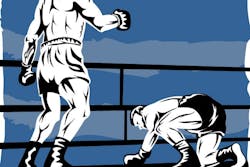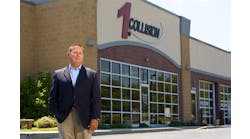The recession might be over (it officially ended in 2009), but that hasn’t slowed the trend of body shop closures at dealerships, according to a report from the National Automobile Dealers Association (NADA).
A decade ago, 43 percent of franchised dealerships had body shops on site, the report says, but today only about 33 percent of the nation’s roughly 17,700 dealers still have shops. Total dealer shop sales have also declined in recent years, tumbling from nearly $10 billion in 2007 to roughly $6.5 billion in 2010.
Paul Taylor, chief economist for NADA, says equipment costs, evolving vehicle structures, stricter environmental regulations, staffing challenges and stiffer competition from independent shops have contributed to the closures and sales dip. He expects sales to rebound as the economy improves, but he’s not as optimistic about shop numbers.
— Dustin Womble, operating partner, Roger Beasley Collision Center
“We would expect for future years to see the number of dealers having on-site shops to continue to trend down, but average activity per location to go up as consumers buy new cars and maintain cars better,” Taylor says.
He says that these days, more franchised dealerships are opting to use one centralized body shop rather than a shop at each site.
Dustin Womble, operating partner with Austin, Tex.–based Roger Beasley Collision Center, serves seven of nine dealerships that way. The 38,000-square-foot shop—28,000 square feet when it opened eight years ago—provides its dealers with repair consistency, reduced overhead and fewer management headaches compared with maintaining a shop at each dealership, Womble says.
He says other dealer shops have closed in his market, but only because their franchises were consolidating shop operations.
“The number of dealer shops has [decreased], but the ones that are still in the game are getting bigger and better,” Womble says.
Travis Rice, manager of collision operations for Gulf States Toyota, says his five-state operation runs 49 body shops at 154 dealers and the number of service centers is growing. He says body shops can provide dealers a big pot of additional profit if they are run well, but many managers don’t know the body shop business.
The success of a shop, Rice says, is largely dependent on the manager. As standards for collision repair have increased and the industry has grown more technical and regulated, many dealership owners didn’t keep up, he says.
“Everything we do, the entire car industry, is focused on supporting sales,” Rice says. “Many general managers educated themselves in service and parts, but many didn’t get educated on body shops.”
Rice says more than 40 percent of Gulf Toyota’s parts sales are made through its body shops, and dealers with shops seeing profit margins around 20 percent higher than their counterparts without repair facilities. The body shops also serve as a customer retention tool for the dealerships.
“Toyota supports its collision centers, and the staff in the field is dedicated to them,” Rice says.
He says independent shops are increasingly more capable, but dealers that invest in their own facilities will be able to keep up and even maintain an advantage because of their connection to the manufacturer.
“I know that Toyota customers and import customers would rather go to dealership because they understand the value of certification and factory parts,” he says.
Despite the decline in dealership shop numbers, dealers as a whole improved financially in 2010, according to the NADA report. Net profitability before taxes jumped to 2.1 percent, compared to 1.5 percent in 2009.
“New-car dealerships improved their profitability in 2010 through strict cost control, such as reducing rent and real estate costs, cutting advertising expenses and maintaining lower floor plan costs,” Taylor says.


